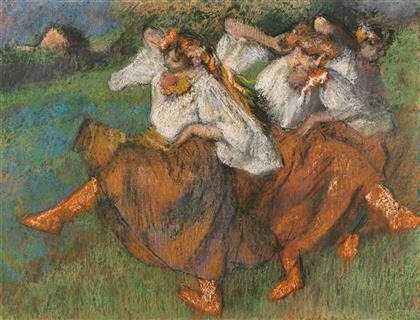
Russian Dancers, 1899.
Edgar Degas (French, 1834 – 1917).
Pastel and brush. 22 7/16 x 29 1/2 in.
Private Collection
Degas: Russian Dancers and Art of Pastel at the Getty ‘Degas: Russian Dancers and the Art of Pastel’: Getty Museum presents a focused installation of late 19th-century French pastels. May 19–October 11, 2015.]]>
Source: J. Paul Getty Museum
In 1899, Edgar Degas (1834-1917) began a group of drawings and pastels depicting folk dancers which included one of his greatest late works, “Russian Dancers”. This magnificent work, on loan to the Getty Museum from a private collection, is the centerpiece of a focused installation of late 19th-century French pastels titled Degas: “Russian Dancers” and the Art of Pastel, which opens on May 19 and continues through October 11, 2015.
“Russian Dancers” is from a monumental series of drawings and pastels that Degas made late in his career when he was fascinated by troupes of Ukrainian folk dancers that performed in Parisian cafes in the late nineteenth century. These works depict a style of dance far removed from the world of ballet for which Degas is so rightly famous. In contrast to his ethereal ballerinas, these peasant dancers, clad in elaborate, brightly colored folk costumes, danced with earthy, rambunctious abandon, stomping on the ground and flinging their arms above their heads.
During the 1880s, Degas increasingly turned away from oil paint in favor of the brilliant, powdery medium of pastel. Rolled into sticks, often by hand, artists could apply pastel color directly to paper, as in a drawing. The ease of execution and immediacy of the medium, which could be removed without consequence to the work in progress, suited Degas’s constant reworking of compositions and poses.
Degas had used pastel his entire career, but in late works like “Russian Dancers” he developed a unique way of working the medium, which involved applying numerous layers of various pure colors on top of one another, with each layer stabilized by fixative. Tracing paper also played an important role in this process, allowing for a range of compositional elements to be replicated, arranged, and rearranged across a series of works.
Related content
Works of paper by Degas, Renoir at DIA Detroit (exhibition, 2014)
Follow us on:


